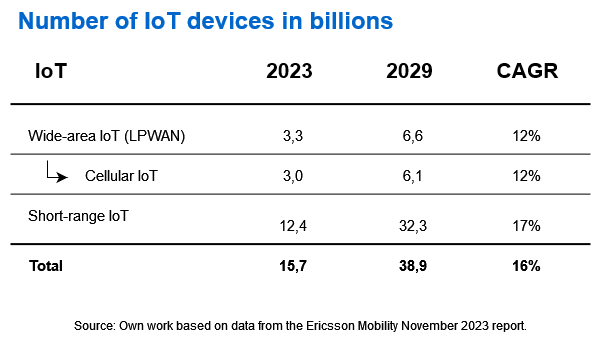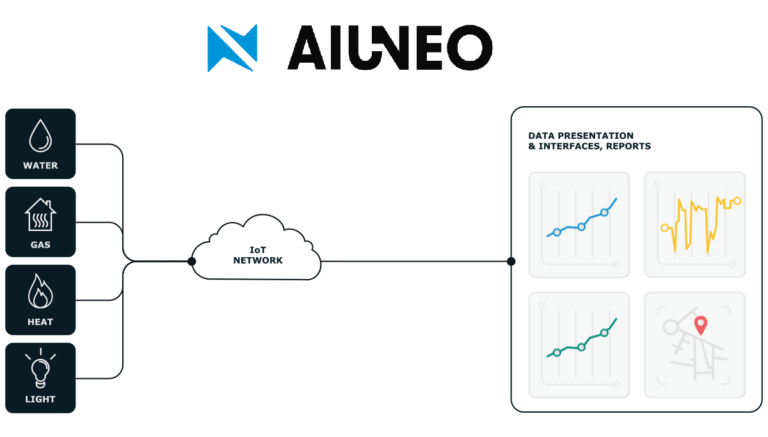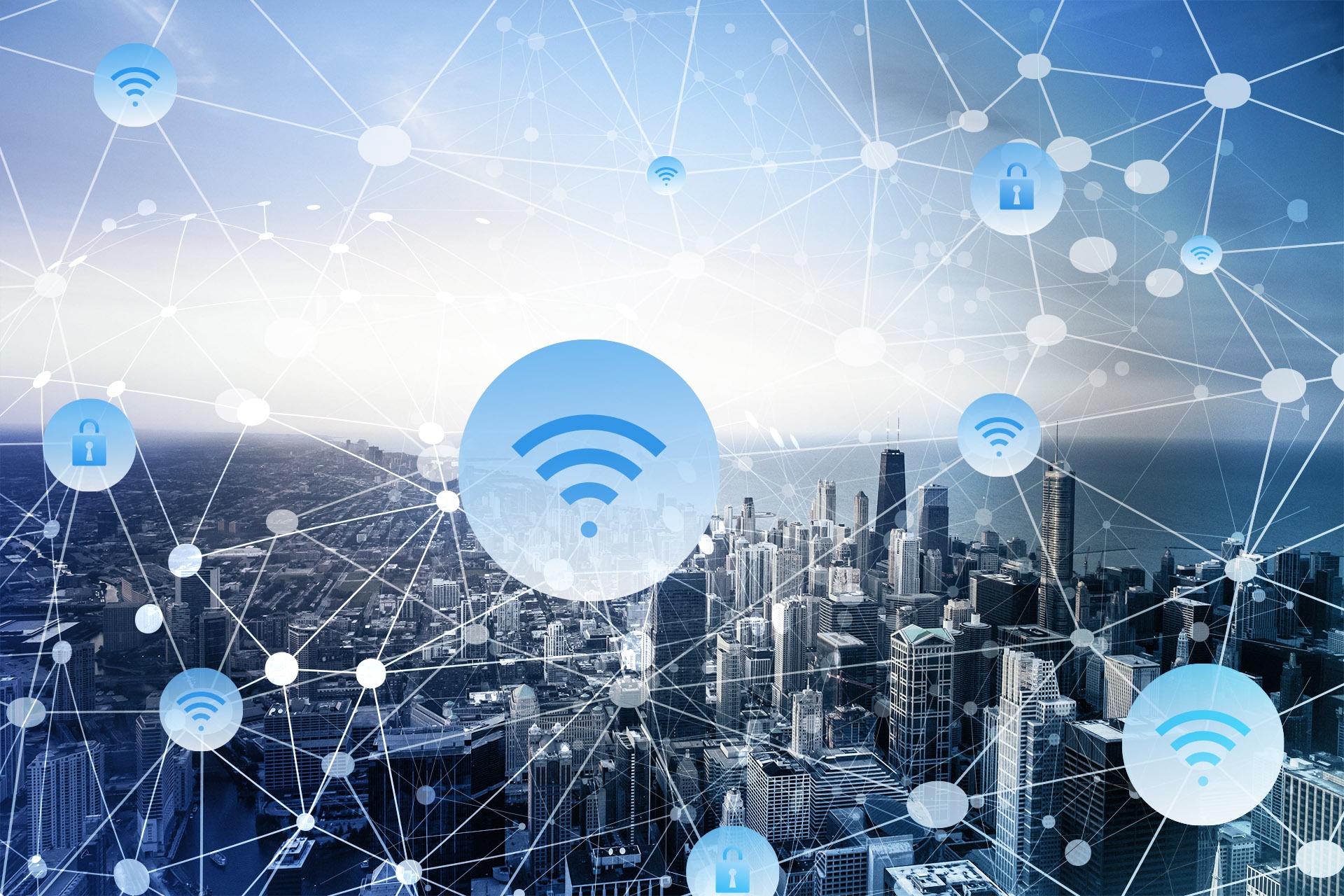
LoRa vs. 5G for IoT applications: Which is best for you?
In this article, you will learn:
-
how many IoT devices are currently on the market?
-
about the origins of LoRa and LoRaWAN wireless communication technologies.
-
what is LoRa and where is it used?
-
what is LoRaWAN and what does the LoRaWAN network architecture look like?
-
what are the characteristics of the 5G telecommunication network?
-
how do LoRa and the 5G telecommunication network differ?
Every IoT (Internet of Things) solution starts with a sensor sending data, and every sensor needs a network for communication. This is all to make better decisions based on collected and structured data and strive for more sustainable future development. In the world of IoT, many communication solutions such as LoRa, Sigfox, NB IoT, LTE Cat-M, GSM 2G, 3G, 4G, and 5G that enable communication between devices. In this article, we will look at two of the most popular ones — LoRa (Long Range) technology and 5G cellular telephony used in the Industrial Internet of Things (IIoT). With their help, it is possible to create more intelligent and sustainable ecosystems of interconnected IoT devices. However, choosing the right technology can be a key success factor for your projects.
How many IoT devices are currently on the market?
The Ericsson Mobility Report released in November 2023 presents research on the number of IoT devices in billions. It is estimated that by 2029, the number of IoT devices worldwide will grow at a CAGR of 16%. In 2029, the number of IoT devices will reach 38.9 billion from the initial 15.7 billion in 2023. The growth rate predicted for long-range connections (LPWAN — Low Power Wide Area Network) is 12%, and for short-range IoT 17% during the forecast period. Among the most popular LPWAN standards, which provide low-power and long-range wireless networks, are LoRa, NB-IoT, and LTE Cat-M.
The origins of LoRa and LoRaWAN wireless communication technologies
The beginnings of LoRa transmission technology date back to 2009. At that time, two friends from France — Nicolas Sornin and Oliver Seller — came up with the idea of developing a long-range, low-power radio wave modulation technology. In 2010, they were joined by Francois Sofrze, with whom they founded CYCLEO, a company dedicated to developing wireless communication technology for gas and energy meters. For this purpose, they began to use CSS (Chirp Spread Spectrum) technology, which was borrowed from the world of dolphins and bats and had previously been used in aviation and sonars. Although the mentioned scientists did not create the entire technology, the concept of using CSS technology as a method of transmitting data over long distances initiated a new chapter in research. In 2012, CYCLEO was acquired by Semtech, which completed the development of the technology for devices and created a protocol to operate them, which is now called LoRaWAN.

What is LoRa?
LoRa is one of the IoT transmission technologies that provides low-power wireless communication between devices. Its operation is based on CSS radio modulation technology, in which small pulses are used to encode information using radio waves. As the acronym LoRa (Long Range) suggests, it is a long-range wireless communication system. LoRa technology has revolutionized IoT by enabling data transmission over long distances, thus filling the technological gap between cellular networks, Wi-Fi, or Bluetooth Low Energy (BLE). LoRa is ideal for low-power devices and those that transmit small amounts of data daily.
Applications of IoT devices in industry
An example of devices that operate based on LoRa technology are IIoT sensors deployed in various industrial sectors. They are used, for example, in smart city management (including energy, heat, water, lighting), measurements and utility services, pollution control, healthcare, logistics, industry, agriculture, disaster prevention, and environmental monitoring.
One of the market companies focusing on smart city solutions and projects is AIUT brand AIUNEO. AIUNEO provides remote water, gas, and heat meter systems and modern city management solutions, including street lighting and parking management. It uses various wireless transmission technologies, including LoRa technology.
What is LoRaWAN?
LoRaWAN is a communication protocol and system architecture for the network. It was created by the LoRa Alliance consortium in 2015, a non-profit association of over 500 companies responsible for developing, maintaining, and promoting the open, cloud-based LoRaWAN standard. AIUT has been a member of LoRa Alliance since 2017 and participates in working groups developing the protocol standard within the organization.
LoRaWAN operates in ISM bands below 1 GHz. These are worldwide, unlicensed bands intended for industrial, scientific, and medical applications. The frequencies of these bands differ depending on the group of countries. This is due to the fact that each has different regulations regarding the allocation and sharing of radio bands. In Europe, the LoRaWAN system operates in the 433 or 868 MHz band. Detailed frequency ranges for specific countries can be found here.
LoRaWAN network architecture
The LoRaWAN architecture consists of four main parts: nodes, gateways, the LoRa Network Server (LNS), and the application server.
Nodes are field devices — sensors and loggers for periodic data collection and monitoring. They send a message that is received by all gateways within radio range. The gateways then forward the message to the LoRa Network Server (LNS). The network server is responsible for organizing transmissions between devices: identifying and managing the transmission parameters of end nodes, routing between gateways, encrypting communication, and integrating and providing collected data to the application server via an API (Application Programming Interface). The application server processes the transmitted data based on the end device address, enabling its use directly in the end user's applications.
The LoRa network structure, i.e., the connections of nodes to gateways and those to the LNS, forms a star network — nodes cannot communicate directly with each other. However, communication between the gateway and the node is bidirectional, so it is also possible to force the device to perform certain actions or change configuration parameters.
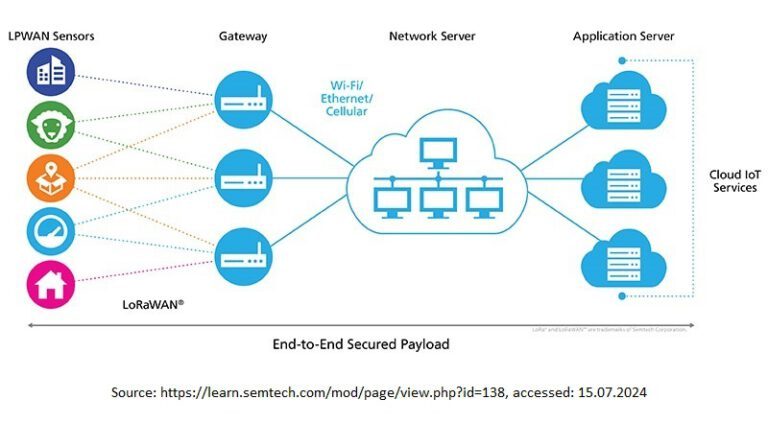
Semtech's website states that in March 2023, there were 5.9 million gateways with LoRa devices (March 2023) and 300 million nodes with deployed LoRa devices worldwide.
GSM 5G: Revolution in mobile communication. Characteristics of the 5G network.
The 5G network (fifth generation cellular network) is the latest wireless technology that brings significant improvements in speed, bandwidth, capacity, and latency compared to previous generations (4G LTE, 3G, etc.). 5G reaches speeds of up to 10 gigabytes per second, providing speeds from 10 to 100 times faster (depending on the distance from the telecom tower and the surrounding environment) than the 4G network. Additionally, it can handle significantly more devices in a small area. It is said that up to 1 million devices per square kilometer are possible, which is crucial for IoT development. For consumers, this means not only faster mobile Internet but also widespread Internet connectivity in many everyday devices such as cars or smart homes. The 5G network uses both lower frequency bands below 6 GHz and higher millimeter-wave bands (mmWave) from 30 to 300 GHz, which offer very high bandwidth. It also provides low latency, reducing the delay from 200 milliseconds in 4G to just 1 millisecond, which is important in solutions requiring fast, real-time interactive communication.
5G applications include Industry 4.0, medicine, autonomous vehicles, smart cities, entertainment and media. In the AIUT Group, examples of deployments using 5G technology are Aformic's Autonomous Mobile Robots (AMR) and Automated Guided Vehicles (AGV), which perform logistics tasks within a production plant, communicating in the cloud online. Thanks to 5G technology, it is possible to manage a fleet of mobile robots online and create a complete intralogistics system — an internal transport system. However, deploying 5G requires significant infrastructure investments, appropriate regulations, and security solutions to protect networks from cyber threats.

Comparison between LoRa and the 5G telecommunication network
Costs
The costs of implementing LoRa technology are lower, mainly due to simpler network infrastructure and lower operating costs. GSM networks, especially 5G, require large infrastructure investments and higher maintenance costs. Using the cellular network, we are dependent on the tariffs of our local operators — fees for using the 5G network are paid as a subscription for each device, which must be equipped with its own 5G-compatible SIM card. However, suppose we comply with the norms and regulations of the LoRaWAN network. In that case, we can create our own private LoRa network and use it for free — we do not have to bear the costs of maintaining the network to external service providers, and we only need to invest in equipment. Additionally, the cost of producing radio modules compliant with the LoRaWAN specification is small.
Range
The actual application distances of LoRa technology allow for the communication of devices within a radius of 1 to 5 km from the gateway in urban areas, while in rural areas, it can range from a few to several kilometers. In the case of the 5G telecommunication network, high-frequency millimeter waves have a limited range of several hundred meters to a few kilometers. As for lower 5G frequencies, they reach a range of up to several kilometers at the cost of lower data transmission speeds. The 5G network is also more susceptible to interference caused by physical obstacles such as buildings and trees and requires a larger number of base stations to ensure full network coverage.
Data throughput and communication speed
LoRaWAN is a standard focused on transmitting small data packets from end devices. In contrast, cellular technology provides high throughput, enabling the transmission of large data such as images or videos. The data transmission rate for sensors using LoRa technology ranges between 0.3 kb/s and 37.5 kb/s. Therefore, it achieves significantly lower values compared to 5G networks, which can reach speeds of up to 10 gigabits per second.
Power consumption
LoRa is characterized by low power consumption. Sensors operating on LoRa are battery-powered and can operate for up to 10 years. In contrast, 5G devices, due to the transmission of large amounts of data, have high energy consumption. Industrial applications of devices using 5G transmission typically require either mains power or periodically charged batteries.
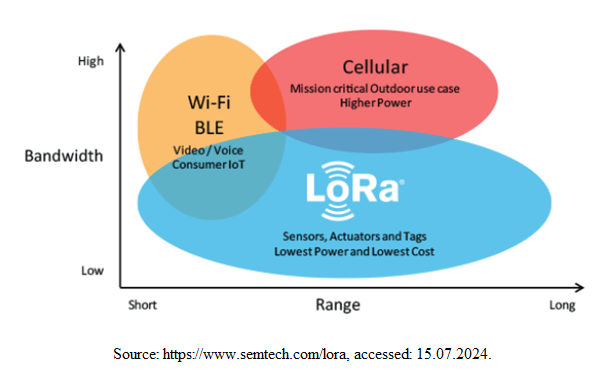
Summary
The choice between LoRa and 5G depends on the specific requirements of your IoT application. LoRa is ideal for applications requiring long range and low power consumption, with limited data transmission speed requirements. Thus, it is perfect for remote meter readings for water, gas, heat and for monitoring smart city infrastructure – such as parking spaces or municipal waste containers. This is a world of devices where small data packets can be delivered periodically and asynchronously, allowing the LoRa network to handle millions of end devices. On the other hand, 5G cellular technology is ideal for applications requiring high throughput and very low latency, in the order of single milliseconds. The 5G network is used in real-time video transmission, online gaming, autonomous AGV vehicles and industrial robots, VR/AR applications, and remote medical operations.

Are you interested in learning about our remote water, gas, heat meter reading solutions and city management?
Discover the future of smart metering and Smart City solutions with AIUNEO. With nearly 20 years of experience in telemetry, IoT, smart metering systems, AIUNEO is your trusted partner in innovative solutions for the utilities sector.
